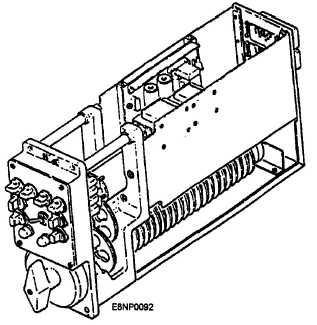Figure 5-25.-JR Switch (type 4).
direction systems use control signals
provided by the multiplexing data converter
to activate the switches and provide
status signals back to the converter to indicate
switch position to the system.
Each panel contains a REMOTE-MANUAL
toggle switch. The servo system controls the
position of the AJR switch when the toggle
switch is in the REMOTE position. The toggle
Figure 5-26-Remotely operated JR switch
panel assembly.
switch must be placed MANUAL to allow
personnel to rotate the switch
Linear Movement Switches
In newer switchboards and upgrades to older
switchboards, the rotary-type JR and AJR
switches have been replaced by linear movement
switches with the same electrical configurations as
the JR switches. We covered linear movement
switch panel assemblies in the Mk 70 DFCS.
END-AROUND-TEST
One of the functions provided by both analog
and digital switchboards is the end-around-test
(EAT). When switches are in the EAT position,
switchboards take the output of a device and feed
it back to the same or similar device as input data.
For instance, a control signal generated by a
device such as the keyset central multiplexer
(KCMX) can be routed end-around as a status
signal input. The output of a digital-to-synchro
(D/S) converter can be fed end-around to a
synchro-digital (MD) converter or the output
channel of a computer can be end-around as an
input channel for the same computer. EAT allows
for offline testing and verification of the
operability of digital and analog interfaces, both
within the CDS and external to the CDS.
5-15



